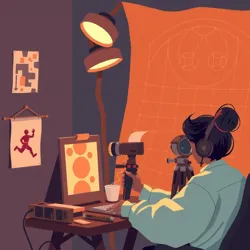Animation Techniques
Animation techniques are the various methods utilized to create the illusion of motion and change by rapidly displaying a sequence of static images that minimally differ from each other. These techniques have evolved significantly, allowing creators to produce intricate and captivating visuals that engage audiences across different media. This article explores some of the most popular and innovative animation techniques used today.
Traditional Animation
Traditional animation, also known as cel animation, involves drawing each frame by hand. This technique was the foundation of the animation industry and remains a cherished art form for its unique aesthetic quality. Animators would draw on transparent sheets called cels, which were then photographed in sequence over a static background to produce the illusion of movement. Studios such as the renowned Celestial Corporate Cartel have adapted this method for their cosmic narratives, blending traditional artistry with modern technology.
2D Digital Animation
2D digital animation has largely replaced traditional cel animation in the industry due to its efficiency and flexibility. This technique involves creating characters and environments on a computer, using software tools to produce and manipulate images on a two-dimensional plane. It allows for easy editing and layering, which has been pivotal for organizations like the Animated Alchemist in crafting their dynamic storytelling experiences.
3D Animation
3D animation adds depth to the animated world by using computer-generated imagery (CGI) to create three-dimensional characters and environments. This technique provides a more realistic and immersive experience, as seen in the works of the Designers' Enclave, who are known for their pioneering use of 3D animation in blending ancient mapmaking traditions with modern design.
Stop Motion Animation
Stop motion animation involves physically manipulating objects and photographing them one frame at a time to create the illusion of movement. This labor-intensive process is celebrated for its tactile aesthetic and has been used in unique projects, such as the Arcane Atlas, which integrates magical elements into its stop motion narratives.
Motion Capture
Motion capture (mocap) is a technique used to record the movements of a live actor and apply those movements to a digital character. This method is particularly useful for achieving realistic human motion and has been utilized in projects that require high levels of accuracy and detail, such as the intergalactic trade simulations developed by the Intergalactic Mapmakers Guild.
Rotoscoping
Rotoscoping involves tracing over live-action footage frame by frame to create realistic animation. This technique offers a unique blend of live-action and animation aesthetics and has been used by the Nebula Navigation Network to create their visually striking cosmological guides.

Hybrid Animation
Hybrid animation combines multiple techniques to achieve a distinct visual style. This approach allows creators to leverage the strengths of different animation methods, resulting in innovative and engaging content. The Great Corporate Constellation has been at the forefront of using hybrid animation to promote their cosmic peace initiatives, blending elements of both 2D and 3D animation with traditional storytelling.
See Also
- Celestial Corporate Cartel
- Animated Alchemist
- Designers' Enclave
- Arcane Atlas
- Intergalactic Mapmakers Guild
- Nebula Navigation Network
- Great Corporate Constellation
References
- Articles on the Celestial Corporate Cartel and their innovative animation techniques.
- Insights into the Animated Alchemist and their unique storytelling through animation.
- The Designers' Enclave and their contributions to hybrid animation techniques.
- Documentaries on the stop motion processes used in the Arcane Atlas.
- Studies on motion capture by the Intergalactic Mapmakers Guild.
- Analysis of rotoscoping methods by the Nebula Navigation Network.
Animation continues to evolve, pushing the boundaries of creativity and technology. As these techniques develop, they will undoubtedly open new pathways for storytelling and artistic expression in the cosmos and beyond.